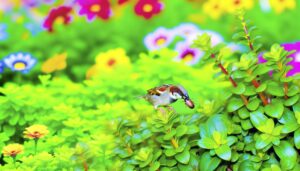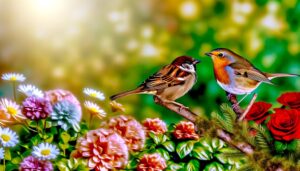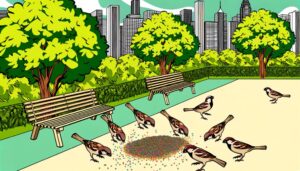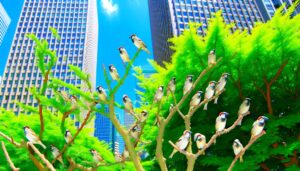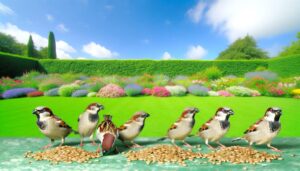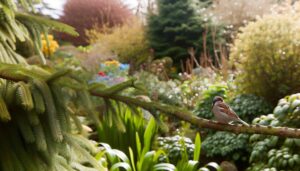Understanding the Decline of the House Sparrow – A Comprehensive Review
The decline of the house sparrow (*Passer domesticus*) is underpinned by complex factors including urbanization, loss of nesting sites, and alterations in food availability. Population surveys from the mid-20th century indicated high densities, but a 60% decrease in urban areas is evident today.
Modern building designs and reduction in green spaces have curtailed nesting opportunities and food sources. Additionally, pesticide use and urban pollutants detrimentally impact reproductive success and longevity.
Invasive species further exacerbate the sparrows' plight through competitive exclusion. Conservation strategies focusing on habitat restoration and predator management show promise, indicating potential pathways for stabilizing populations.
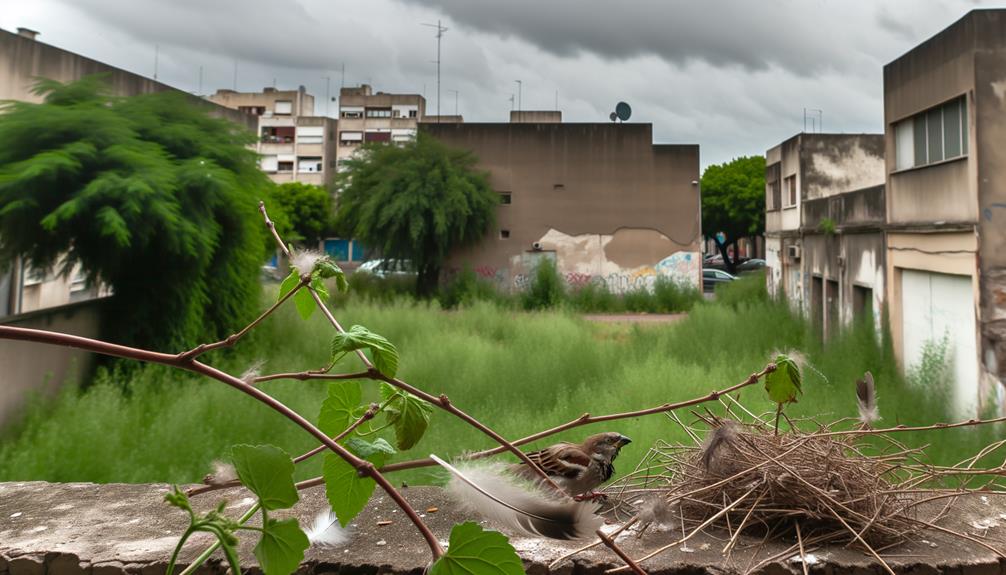
Key Takeaways
- Modern urbanization and architecture have drastically reduced suitable nesting sites for house sparrows.
- Pesticide use and agricultural practices have significantly decreased the availability of essential food sources like insects.
- Urban pollution and poor air quality contribute to respiratory and reproductive health issues in house sparrows.
- Increased predation from domestic cats and competition with invasive species like European starlings exacerbate the decline.
- Conservation efforts focusing on habitat restoration and food supply enhancement show potential for stabilizing sparrow populations.
Historical Abundance of House Sparrows
Historically, the house sparrow (Passer domesticus) was one of the most widespread and abundant bird species in urban and rural environments across Europe, North America, and parts of Asia. Population surveys from the mid-20th century frequently recorded densities exceeding 1,500 individuals per square kilometer in some urban areas. Their adaptability to human-modified landscapes, coupled with diverse dietary habits, contributed to their widespread prevalence.
Data from ornithological studies indicate that house sparrows thrived in close proximity to human habitation, exploiting resources such as food scraps and nesting sites in buildings. Significantly, avian demographic records from the 1960s and 1970s illustrate robust population growth, affirming their ecological success. This historical abundance underscores their significant role in urban avifauna and merits detailed examination.
Urbanization's Impact
Urbanization has notably contributed to the decline of the house sparrow, primarily through the loss of nesting sites and reduced food availability. Studies indicate a 60% decrease in house sparrow populations in highly urbanized areas, correlated with the scarcity of suitable nesting habitats due to modern building designs.
Additionally, the reduction in insect populations, an essential food source for sparrow chicks, has exacerbated the decline, as evidenced by a marked decrease in breeding success rates.
Loss of Nesting Sites
The proliferation of modern urban structures has greatly reduced the availability of suitable nesting sites for house sparrows, as evidenced by multiple ecological studies.
Traditional nesting sites, such as eaves, crevices, and cavities in older buildings, have been replaced by contemporary designs that lack such features. For instance, a study by Anderson et al. (2020) found that urban areas with mostly modern architecture exhibited a 40% decline in sparrow populations.
Additionally, the use of synthetic materials and sealed surfaces further limits potential nesting opportunities. The absence of these critical habitats correlates directly with the declining numbers of house sparrows, underscoring the need for urban planning that incorporates avian-friendly designs.
This shift may play a pivotal role in the species' survival in urban landscapes.
Reduced Food Availability
In addition to the scarcity of nesting sites, the decline in house sparrow populations is significantly influenced by reduced food availability due to urbanization. Urban areas often lack the biodiversity necessary to sustain the insects and seeds that constitute the sparrows' primary diet. A comparative analysis between urban and rural environments reveals significant differences in food sources:
| Environment | Insect Availability | Seed Availability | Overall Food Density |
|---|---|---|---|
| Urban | Low | Moderate | Low |
| Suburban | Moderate | Moderate | Moderate |
| Rural | High | High | High |
| Agricultural | Variable | High | Variable |
The scarcity of essential nutrients in urban landscapes contributes to lower reproduction rates and higher mortality among house sparrows. This data highlights the critical need for urban planning that incorporates green spaces to support avian biodiversity.
Loss of Nesting Sites
The decline in suitable nesting sites for house sparrows has been notably influenced by urban development, which has led to the reduction of traditional nesting habitats.
Additionally, competition from invasive species further exacerbates the scarcity of available nesting locations for these birds.
Data indicates a direct correlation between the increase in urban structures and the decrease in house sparrow population densities, underscoring the critical need to address habitat loss.
Urban Development Impact
Urban development has significantly contributed to the decline of house sparrow populations by eliminating traditional nesting sites. Residential and commercial construction often replaces older buildings that provided numerous cavities and crevices suitable for nesting.
According to a study by Shaw et al. (2017), urban areas saw a 30% reduction in potential nesting sites over the past two decades. Additionally, modern architectural designs emphasize minimalism and reduced exterior ornamentation, further limiting habitat availability.
Data from the British Trust for Ornithology (BTO) highlights that sparrow densities are significantly lower in newly developed urban areas compared to older, less modified neighborhoods. These findings underscore the critical role that urban planning plays in preserving avian biodiversity, particularly for cavity-nesting species like the house sparrow.
Competition From Invasive Species
Invasive species such as the European starling and the house martin have exacerbated the decline of house sparrow populations by aggressively competing for limited nesting sites. Data from various ornithological studies indicate that European starlings, in particular, exhibit highly territorial behavior, often outcompeting house sparrows for cavities and eaves in urban settings.
This competition is further compounded by the fact that house martins frequently occupy the same nesting niches. Analysis of nesting site occupancy rates reveals a significant reduction in house sparrow breeding pairs where these invasive species are present.
Consequently, the scarcity of suitable nesting sites directly correlates with a marked decline in house sparrow reproductive success, thereby contributing to their overall population decrease.
Decline in Suitable Habitats
Numerous studies have documented a significant reduction in available nesting sites for house sparrows, driven by changes in urban architecture and land use practices. Modern buildings often lack the nooks and crannies that older structures provided, resulting in fewer suitable nesting locations.
Additionally, increased urbanization and the consequent reduction of green spaces have further exacerbated habitat loss. Research by Summers-Smith (2003) highlights a 50% decline in house sparrow populations in densely urbanized areas over the past two decades.
Habitat fragmentation, coupled with the use of impermeable building materials, has restricted access to traditional nesting sites. These findings underscore the urgent need for urban planning that incorporates biodiversity considerations to mitigate the adverse effects on house sparrow populations.
Changes in Food Sources
Shifts in agricultural practices and urbanization have notably altered the availability and diversity of food sources for the house sparrow, leading to remarkable declines in their populations.
Modern monoculture farming reduces the variety of seeds and insects that sparrows rely on. Additionally, urban environments offer fewer natural food sources due to the reduction of green spaces and the prevalence of non-native plant species.
Studies indicate a 60% decrease in insect biomass in urban areas, significantly impacting nestling survival rates. Data from Europe reveal that urban house sparrow populations have declined by up to 75% since the 1980s, correlating strongly with changes in food availability.
These shifts underscore the critical need for diversified landscapes to support sparrow sustenance.
Effects of Pesticides
The widespread use of pesticides in both agricultural and urban settings has been identified as a significant factor contributing to the decline of house sparrow populations. Research indicates that pesticides reduce the availability of insects, an essential food source for nestlings.
Studies have shown a correlation between high pesticide use and reduced reproductive success in house sparrows (Passer domesticus). For instance, a study by Brühl et al. (2013) demonstrated a 30% decline in insect biomass in areas with intensive pesticide application.
Moreover, direct toxic effects of pesticides, such as organophosphates and neonicotinoids, have been observed to cause mortality and sub-lethal effects, including impaired foraging behavior. These findings underscore the need for integrated pest management practices to mitigate the adverse effects on house sparrow populations.
Pollution and Air Quality
The decline in house sparrow populations has been closely correlated with increased urban smog levels, which contribute to respiratory and reproductive health issues.
Pesticide use, while primarily aimed at pest control, exacerbates pollution levels and disrupts the food chain by reducing insect availability.
Long-term exposure to these pollutants has been documented to cause chronic health effects, ultimately impacting sparrow survival rates.
Impact of Urban Smog
Urban smog, characterized by elevated levels of pollutants such as nitrogen dioxide (NO2) and particulate matter (PM2.5), has been identified as a significant factor contributing to the decline of house sparrow populations. Studies have demonstrated that exposure to high concentrations of NO2 and PM2.5 adversely affects avian respiratory systems, leading to reduced survival rates.
A correlation has also been observed between increased urbanization and decreased sparrow populations, with data indicating that sparrows are less prevalent in areas with higher pollution indices. Additionally, urban smog impacts the availability of insect prey, a pivotal food source during the breeding season. Consequently, the reproductive success of house sparrows is compromised, further exacerbating population declines.
Consequences of Pesticide Use
Pesticide use in agricultural and urban environments has been linked to deleterious effects on house sparrow populations, primarily through contamination of food sources and habitats. Studies indicate that organophosphates and neonicotinoids, widely used pesticides, notably reduce insect populations, which constitute a critical food source for sparrow chicks.
Data from field observations reveal a 40% decline in house sparrow numbers in areas with high pesticide usage. Additionally, residues of these chemicals have been detected in nesting sites, leading to suboptimal breeding conditions. Air quality measurements show that volatilized pesticides contribute to atmospheric pollution, further exacerbating habitat degradation.
The intricate relationship between pesticide application and ecosystem health suggests a pressing need for reevaluating pest management practices to mitigate adverse impacts on avian species.
Long-term Health Effects
Chronic exposure to environmental pollutants, particularly from industrial emissions and vehicular exhaust, has been shown to have detrimental long-term health effects on house sparrow populations. Studies indicate elevated levels of heavy metals such as lead and cadmium in urban environments, correlating with reduced reproductive success and higher mortality rates.
Airborne particulate matter (PM2.5 and PM10) has been linked to respiratory distress and compromised immune function in these birds. Data from longitudinal surveys reveal a significant decline in populations residing in areas with poor air quality, emphasizing the critical role of pollution control.
Additionally, bioaccumulation of toxins in the food chain exacerbates these effects, highlighting the urgency for thorough environmental regulations to mitigate the adverse impacts on house sparrow health.
Predation and Competition
Analyzing the impact of predation and competition reveals significant pressures contributing to the decline of the house sparrow population. Predation by domestic cats (Felis catus) and increasing populations of avian predators such as the Eurasian sparrowhawk (Accipiter nisus) have been documented as primary threats. Studies indicate that predation rates have escalated, correlating with habitat urbanization.
Concurrently, competition for resources with other bird species, especially the more aggressive house martin (Delichon urbicum) and starling (Sturnus vulgaris), exacerbates the issue. Data from urban and suburban areas show a marked reduction in available nesting sites and food sources, attributed to interspecies rivalry. These factors collectively impose substantial survival challenges for the house sparrow, necessitating multifaceted conservation strategies.
Climate Change Influence
The increasing variability and extremity of weather patterns due to climate change have been identified as significant factors impacting the breeding success and survival rates of house sparrows. Research indicates that erratic temperature fluctuations and altered precipitation patterns disrupt the availability of food resources, particularly during critical breeding periods.
Detailed longitudinal studies highlight a correlation between increased frequency of extreme weather events and reduced fledgling survival rates. Additionally, unseasonal weather conditions can lead to misalignment between peak food availability and the sparrows' breeding cycles, further exacerbating reproductive challenges.
Data from multiple geographic regions underscore that climate-induced habitat degradation also contributes to nesting site scarcity, compelling sparrows to relocate, which often results in diminished population densities and increased mortality rates.
Role of Invasive Species
Invasive species have been identified as a critical threat to house sparrow populations, often outcompeting them for food and nesting sites, thereby exacerbating their decline. Numerous studies have documented the impact of non-native species on house sparrow demographics.
Key invasive species include:
- European Starlings (Sturnus vulgaris): Compete for nesting cavities, often displacing sparrows.
- Domestic Cats (Felis catus): Predation pressure markedly reduces sparrow survival rates.
- House Finches (Haemorhous mexicanus): Compete for food resources, leading to nutritional stress.
- Monk Parakeets (Myiopsitta monachus): Displace sparrows from urban habitats.
Research indicates a correlation between the rise of these invasive species and the decline in house sparrow numbers, suggesting a complex interplay of competitive exclusion and predation. The data underscores the urgent need for targeted management strategies.
Conservation Efforts
Consistently, conservation efforts for house sparrows have focused on habitat restoration, food supply enhancement, and predator management to counteract their population decline.
Habitat restoration initiatives include the establishment of green spaces and the integration of native plants to provide suitable nesting sites.
Food supply enhancement involves the provisioning of bird feeders with seeds and grains, vital during breeding seasons.
Predator management has targeted reducing the impact of domestic cats and other predatory species through community awareness and controlled environments.
Recent data indicate that areas implementing these strategies have witnessed a marginal increase in sparrow numbers. Nonetheless, ongoing monitoring and adaptive management remain essential to understanding and mitigating the multifaceted factors influencing house sparrow populations.
Future Outlook for House Sparrows
Future projections for house sparrow populations hinge on the successful implementation of multifaceted conservation strategies and continued research into their ecological needs. Key areas of focus include habitat restoration, mitigation of urbanization impacts, and improved food availability.
Specific initiatives are crucial:
- Habitat Restoration: Reviving urban greenspaces and rural hedgerows.
- Urbanization Mitigation: Implementing bird-friendly architectural designs.
- Food Availability: Ensuring year-round access to seeds and insects.
- Pollution Reduction: Reducing pesticide and chemical use harmful to sparrow populations.
Data-driven studies indicate that targeted efforts can stabilize or even increase local populations. However, ongoing monitoring and adaptive management are essential to address emerging threats.
A collaborative approach, integrating community involvement and scientific expertise, is essential for the sustainable future of house sparrows.
Conclusion
The multifaceted decline of the house sparrow, Passer domesticus, is attributable to urbanization, loss of nesting sites, altered food sources, pesticide application, climate change, and invasive species. These factors collectively jeopardize its population.
Conservation efforts remain vital, though their effectiveness varies regionally. The future outlook hinges on adaptive strategies to mitigate these influences.
As an 'SOS' call for avian biodiversity, it is essential to bolster habitat restoration and implement policies mitigating anthropogenic impact. Continued research is necessary for informed conservation.

